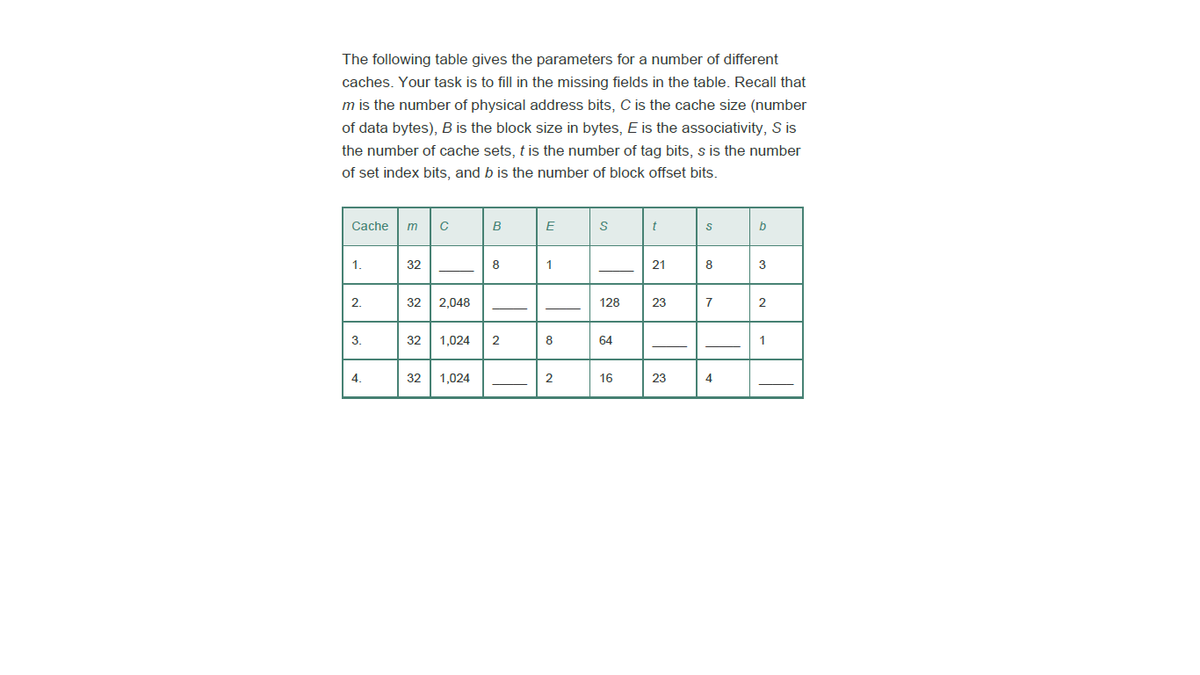The following table gives the parameters for a number of different caches. Your task is to fill in the missing fields in the table. Recall that m is the number of physical address bits, C is the cache size (number of data bytes), B is the block size in bytes, E is the associativity, S is the number of cache sets, t is the number of tag bits, s is the number of set index bits, and b is the number of block offset bits. Cache m В E t 1. 32 8 1 21 8 3 32 2,048 128 23 7 32 1,024 2 8 64 1 4. 32 1,024 16 23 2. 3.
The following table gives the parameters for a number of different caches. Your task is to fill in the missing fields in the table. Recall that m is the number of physical address bits, C is the cache size (number of data bytes), B is the block size in bytes, E is the associativity, S is the number of cache sets, t is the number of tag bits, s is the number of set index bits, and b is the number of block offset bits. Cache m В E t 1. 32 8 1 21 8 3 32 2,048 128 23 7 32 1,024 2 8 64 1 4. 32 1,024 16 23 2. 3.
Computer Networking: A Top-Down Approach (7th Edition)
7th Edition
ISBN:9780133594140
Author:James Kurose, Keith Ross
Publisher:James Kurose, Keith Ross
Chapter1: Computer Networks And The Internet
Section: Chapter Questions
Problem R1RQ: What is the difference between a host and an end system? List several different types of end...
Related questions
Question
The following table gives the parameters for a number of different
caches. Your task is to fill in the missing fields in the table. Recall that m is the number of physical address bits, C is the cache size (number of data bytes), B is the block size in bytes, E is the associativity, S is the number of cache sets, t is the number of tag bits, s is the number of set index bits, and b is the number of block offset bits.

Transcribed Image Text:The following table gives the parameters for a number of different
caches. Your task is to fill in the missing fields in the table. Recall that
m is the number of physical address bits, C is the cache size (number
of data bytes), B is the block size in bytes, E is the associativity, S is
the number of cache sets, t is the number of tag bits, s is the number
of set index bits, and b is the number of block offset bits.
Cache
m
В
E
t
1.
32
8
1
21
8
3
32
2,048
128
23
7
32
1,024
2
8
64
1
4.
32
1,024
16
23
2.
3.
Expert Solution
This question has been solved!
Explore an expertly crafted, step-by-step solution for a thorough understanding of key concepts.
This is a popular solution!
Trending now
This is a popular solution!
Step by step
Solved in 3 steps

Recommended textbooks for you

Computer Networking: A Top-Down Approach (7th Edi…
Computer Engineering
ISBN:
9780133594140
Author:
James Kurose, Keith Ross
Publisher:
PEARSON

Computer Organization and Design MIPS Edition, Fi…
Computer Engineering
ISBN:
9780124077263
Author:
David A. Patterson, John L. Hennessy
Publisher:
Elsevier Science

Network+ Guide to Networks (MindTap Course List)
Computer Engineering
ISBN:
9781337569330
Author:
Jill West, Tamara Dean, Jean Andrews
Publisher:
Cengage Learning

Computer Networking: A Top-Down Approach (7th Edi…
Computer Engineering
ISBN:
9780133594140
Author:
James Kurose, Keith Ross
Publisher:
PEARSON

Computer Organization and Design MIPS Edition, Fi…
Computer Engineering
ISBN:
9780124077263
Author:
David A. Patterson, John L. Hennessy
Publisher:
Elsevier Science

Network+ Guide to Networks (MindTap Course List)
Computer Engineering
ISBN:
9781337569330
Author:
Jill West, Tamara Dean, Jean Andrews
Publisher:
Cengage Learning

Concepts of Database Management
Computer Engineering
ISBN:
9781337093422
Author:
Joy L. Starks, Philip J. Pratt, Mary Z. Last
Publisher:
Cengage Learning

Prelude to Programming
Computer Engineering
ISBN:
9780133750423
Author:
VENIT, Stewart
Publisher:
Pearson Education

Sc Business Data Communications and Networking, T…
Computer Engineering
ISBN:
9781119368830
Author:
FITZGERALD
Publisher:
WILEY